Public
Program57
"Artist Talk" was held.
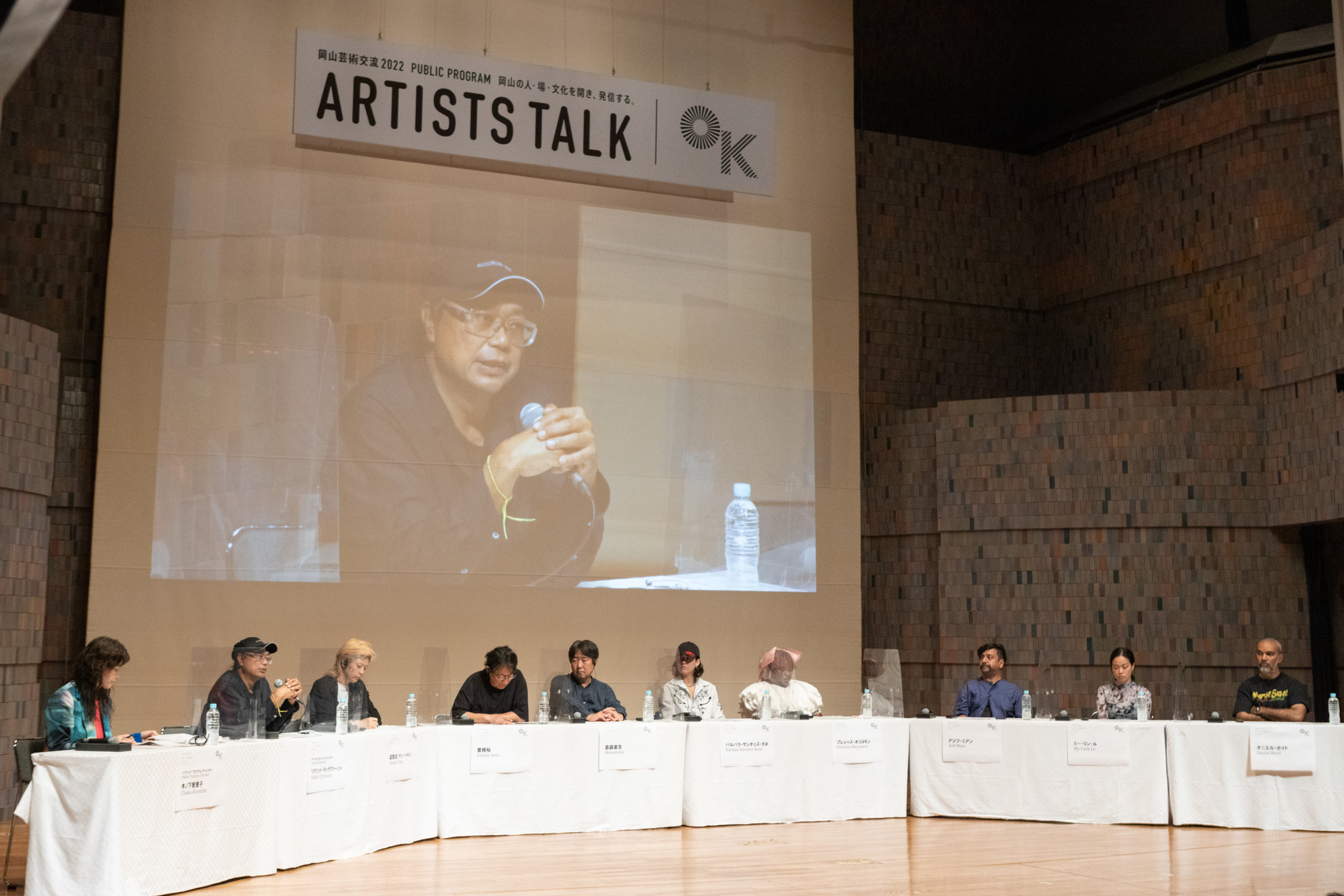
Participating artists discussed about their works to be exhibited this time
and their thoughts about Okayama Art Summit2022.
PUBLIC PROGRAM [ARTISTS TALK]
English - Original text
▼ Master of Ceremony
Chieko Kinoshita
▼Participating Artists
Rirkrit Tiravanija
Daniel Boyd
My-Linh Le
Asif Mian
Precious Okoyomon
Barbara Sanchez-Kane
Shimabuku
Yutaka Sone
Haegue Yang
Event MC:
Hello everybody. Thank you for waiting. Finally, Okayama Art Summit 2022 Public Program Artist talk is to begin. Okayama Art Summit is held every three years in Okayama City. In 2022, Mr. Rirkrit Tiravanija serves as artistic director, and the festival will be held at various historical and cultural facilities in the area around Okayama Castle and Okayama Korakuen Garden for approximately two months from today, September 30, to November 27. Today as the opening event, we're going to have a special talk by participating artists, including Mr. Rirkrit Tiravanija and other world-renowned artists. We hope that you will not only see the exhibited artwork, but also encounter the thoughts of the artists and enjoy interaction with art that moves back and forth between time, history, and national borders, here in Okayama. Now, I would like to pass the baton to Ms. Chieko Kinoshita, Director of the Okayama Art Summit 2022 Public Program. Please enjoy the special talk.
Chieko Kinoshita:
Hello everyone. Thank you very much for coming to the Artists Talk today, even though it is a weekday afternoon. Today, we will proceed in two ways, online and here at Okayama Prefectural Museum of Art, which has provided us with the venue. The Artists Talk, which is the opening event of the Okayama Art Summit 2022, is part of the Public Program and a series of events held with people from Okayama City and beyond, with the aim of opening up, taking root, and sustaining development in the Okayama region, and how we, as hosts, can welcome the triennial international exhibition held in Okayama with local residents.
This morning, just after the opening of the exhibition, you may have witnessed children enjoying the lawn artwork by Mr. Rirkrit at Former Uchisange Elementary School, and in the public program, students from about 100 schools in Okayama City and Okayama Prefecture, will be invited to participate in various projects including tours. For example, there will be newspaper publications by student groups, publicly solicited projects by people in and outside of Okayama city, and dialogue tours with children navigators conducted in collaboration with local groups of Visual Thinking Strategy. We hope you will enjoy these events along with the artists' artwork.
Today's Artist Talk features Mr. Rirkrit Tiravanija who is an artistic director of the Okayama Art Summit 2022, and other participating artists renowned around the world. We hope that you will not only see the exhibited artwork, but also encounter the thoughts of the artists and enjoy an exchange with art that moves back and forth between time, history, and national borders, here in Okayama.
First, Mr. Rirkrit Tiravanija will talk about the overall concept of the Okayama Art Summit 2022, including the title and theme, and then each artist will introduce themselves for a few minutes.
The second half of the session will consist of free discussion on two or three themes, so please enjoy one hour and a half session. We hope this will be a time for you to become more familiar with how artists from various perspectives create art, or how they travel the world while creating their artwork.
From here, I'd like to hand it over to Rirkrit. Thank you.
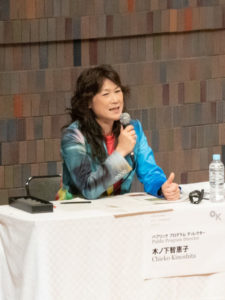
Chieko Kinoshita
Rirkrit Tiravanija:
Thank you. Thank you for being here. Any questions (laughs)? Because you're not going to be able to ask later (laughs). Yeah, I guess it's always for me, always starting with a question. And I've been in this exhibition as an artist in the first installment. I've had a very good experience as an artist in being in this exhibition. I think I was saying at some point that I thought it was quite nice to be in an exhibition that was away from the center, to be in a place a bit away and smaller place and in a way to work with the place and to think about the place that one's in. Therefore, it was quite a good experience for me from the first exhibition.
To be asked to be back here as a kind of an artistic director was like, it was a challenge because I'm not curating an exhibition every day, and having had the experience of being here, of course, I had to think. Since this is the third exhibition, I had to look back at what the other two exhibitions were doing as an exhibition and what kind of questions or artists was shown and how that related in a way to the present time, and what I could do. "Do we dream under the same sky", is not something new for me, it's a statement that kind of floated into my head a while ago, and it's a phrase that I have used for other projects and in different forms.
Therefore, I had the title already before I had the show. However, in a way, when I have to think about putting together an exhibition with other artists, of course, it was easier to have a title and then start to think about really what the shape of the exhibition would be. For me, it was to think about Okayama, to think about what was going on in the world, and also in a way to try to focus a little bit more, I would say, on the one hand, locally in the sense of the region of the area. Also, to look a little bit more in terms of the questions of peripheral discussions. The first two exhibitions were very kind of Eurocentric in a way. That's why I wanted this show to be a little bit more like a kind of compo-centric, something that's not like usually in the center. It's a phrase. It's not a kind of answer. It's not a kind of question, and I would say I was speaking about the idea that we have different dreams or that we all dream in different ways. We dream when we are awake, we dream when we're asleep, we dream when we are trying to get away, the situation with the war in Ukraine. And of course, with climate change and many, many things, I mean. I think it's kind of apocalyptic.
How do we find our ourselves dreaming when we know that we have a condition that is not so optimistic? So, I think, one of the things I wanted to do, of course, was to put the artwork or ask the artists to come here and make work here. And that's one of my kind of perspectives on like what I thought the show could be. Partly because in my own work, I'm interested in always working with the context and working with the people in the place and thinking about why or where the work exists in that situation. There are artists that I know, and even artists that I didn't know have been invited to this exhibition. In a way, I hope in that relationship that they would interact and have a chance to feel the place and meet people and think about the place, and then come up with the work.
In that sense, it was quite difficult because of Covid, and even though I think I asked the artists like maybe more than a year ago if they could participate in the exhibition, nobody could really come here until like five months ago really. Therefore, in that way, it was short notice for the artist to think and be and play and process the place and make the work. However, I think, as maybe if you have seen the exhibition or you will see the exhibition, I think that the artist has responded in ways that I feel fulfill maybe those different dreams that I'm hoping to bring together.
The works are, as you know, it's kind of Okayama, and we have different venues. We have two kinds of museums, very eccentric museums, one being the Okayama Orient Museum, and the other being the Hayashibara Museum, and both are originally private collections or private museums, which is not like a regular kind of space. Then we have the Tenjinyama Cultural Plaza of Okayama Prefecture, which is actually a public exhibition space that is used on a daily basis as a place for people in Okayama to present their activities. When I visited there, of course often I've seen calligraphy competitions of school, elementary school children, or maybe even some poetry calligraphy from older artists, but it's always been a very public place. These are three very different venues, and then including the old elementary school, there has been even something like in Shima's case, his mother went to school there and of course, he wanted to have his work in the school room, which his mother had been in the class. There's a certain kind of memory or certain kind of traces or memory and remembering or return. I felt like, of course as an artist, I kind of have ideas, I think about things, but I don't really know how it all would come together. And I suggested that I would like each artist to make a work in the different spaces or think about the different spaces, and then also put one work inside in a smaller space, which I call the index. At the index, I feel like visitors could see all the artists in the same room and see their work, but also at the same time, in that installation of the works together, they could maybe see how the idea of this same sky could come together.
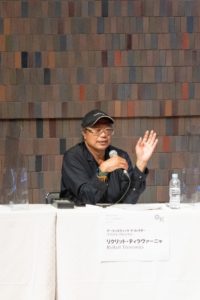
Rirkrit Tiravanija
Chieko Kinoshita:
Thank you very much. I know that some of the artists actually came to Okayama to create artwork, but I thought you chose some of the deceased artists to symbolize their artwork, especially Enku and some other important artists for Mr. Rirkrit. Also, in addition to Enku, I believe many world-traveling artists are participating in this exhibition. Can you make some comments on that as well?
Rirkrit Tiravanija:
In a way, with the title, when I think about the artist and what the exhibition could be, of course, I kind of have a vision of a certain inspiration or points that start things or different artists that maybe are relating with each other. I mean, Enku is a Buddhist monk, who lived like 300 years ago, and somebody like Lygia Clark or David Medalla, are like artists from the older generation that has been an important influence on me in how I look and think of art. In a way, they're like markers for me to how maybe we go through the exhibition. I think the attitudes of the artist and how they work and how they think, for me, I feel like there's a link and inspiration by these older artists who are no longer with us.
Chieko Kinoshita:
Thank you. So, this is an exhibition that brings together the artwork of living artists and those who are not present at the moment, but who are still connected to the present. From here, I would like to ask each of the artists present here today to explain a little about their artwork. Now, I'd like to ask Mr. Daniel Boyd, please.
Daniel Boyd:
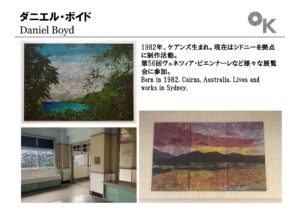 <based on the presentation images>
<based on the presentation images>Okay, so I guess it's important to understand the work and its location. I think, maybe a good way to explain it is the surface, maybe if I just talk about the paintings first. The paintings are made up of these clear translucent dots that sit on the surface and they kind of act as a lens. The lenses are representations of a point of entry or a way of seeing so it's about perception, and I think, historically the representation through art has been something that has kind of assisted certain ideologies that co-opt, the power of art. What I was trying to do with these paintings, in the beginning, was to give some space to a more equitable way of seeing or understanding something.
It's about multiple ways into something and multiple ways out of it, but the surface of the paintings, the way that they interact with light is very important to how you read it. The audiences are put in a position where they kind of has some sense of authorship over the experience with the painting. This opportunity that's there is when you move in front of it, the paintings shimmer, and the paintings were trying to create something that wasn't a static object or an idea that situates itself without any sense of continuum. These works are about the association and how we gain association and how that kind of it's not a linear thing, you know, it offers the opportunity to kind of create some disorder in that sense that that way of representing something.
I guess I kind of think of this surface as like a threshold. It's like black paint in between all of these translucent dots, so it's kind of pointless or something. By holding something back, it makes the audience understand that there is something other than what you see. I feel it's like maybe the entrance to a cave or something where there's this threshold where the sunlight and darkness meet. It's kind of situating yourself in a relationship to light and understanding that kind of connection. In the classroom, in the bottom left image, there are these window works that give people a sense of the trajectory of the sun. It's about how our relationship with the sun and, it's about situating us in a particular context. That's where the work came from.
Chieko Kinoshita:
Thank you. Next, then Ms. My-Linh, please.
My-Linh Le:
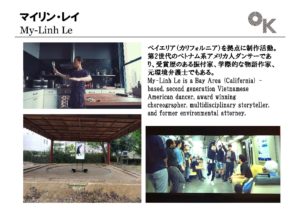 <based on the presentation images>
<based on the presentation images>Hi, I'm a dancer and choreographer and on occasion I also make films. Um, I don't generally like to talk about my work, which is why I make art. So here we are (laughs). The first piece on the top left is a short film about my mom, and the title of it is, "Me I Love You Long Time", if you can read in Vietnamese, and if you can't, in English, "Me, Love You Long Time". It's a piece that examines two things, my tendencies to overwork myself, which I believe I learned from my mom because she had this, unbelievable amount of energy. Then the other thing is our rage. I believe they're linked. It's a short film where I'm just robotting the whole time (laughs). As it goes on, I'm just kind of exploring that rage through my movement.
The second piece on the bottom right here is, a still image from a short film I made with some dancers in Oakland. It combines a little bit of mythology and street dance, and the story unfolds in two paths. One is about a man who prays to the moon and asks the moon to separate him from his shadow, and then immediately regrets that wish when he gets it. So, the story is about him looking for his shadow again. The second storyline is about a group of friends who are preparing themselves for a dance battle. It's about the tensions between, our ambitions and our loyalties to the people we love.
Then the last piece on the bottom left there is the work that I'm presenting here. It's titled, "demons of good dreams", and it's a series of dances made for film and live performance featuring local dancers, from here in Okayama as well as Hyogo and Osaka. It was a new work that was made, especially for Okayama Art Summit 2022, right here in the city, and it was a very quick process, but also very intense. It was really important to me to collaborate with the dancers and get to know them and to get to know the Japanese culture through our conversations and collaboration. That's it. Thank you.
Chieko Kinoshita:
Thank you very much. Next, Mr. Asif, please.
Asif Mian:
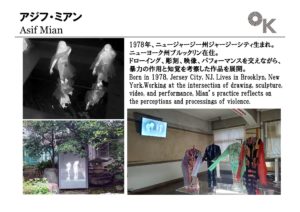 <based on the presentation images>
<based on the presentation images>Hello, my name is Asif Mian. I'm a sculptor and video artist. The work for this exhibition is a series of works where I use thermal cameras, which reads the heat of a person or the heat and display it as white on black. It's kind of an oppressive, instrument for surveillance, but I found it has qualities that, inspired me or like actually created a portal to something more from childhood where I saw them could see people as ghosts or like the image of a ghost or that sort of childhood image, but through, something very present and technological. I want to read a few ideas about this project.
<reads out the following text>
"Not to escape but to transform for the camera. Allowing technology to create the mythological. There and not there. Like the figure of a ghost. That which is neither present nor absent, neither dead nor alive. We created figures from technological traces of heat, the thermal scanning of bodies, seen through material interfaces while embodying liminal performances. Like the characters woven into traditional South Asian rugs, the figures perform as part of a mythology.
Shrouded in a plastic skin that etherealizes under the infrared eye of a flying drone. Each figure is a unique segment of a serpent. Segments connect and shapeshift into the monstrous. Shedding skin, shedding histories that clinging. A remnant of a past someone/someone's past. The technological translation of the mythological: a transgenerational communication. The thermal works are two types of seeing: The actual and the virtual. Two different states of perception, each contending with the other".
We performed in an unused school in Yonkers, New York, near where I'm from, and present the work at an unused school in Okayama, Japan. A mirror of mythology, technology, and place. Thank you.
Chieko Kinoshita:
Thank you very much. Next, Ms. Precious, please.
Precious Okoyomon:
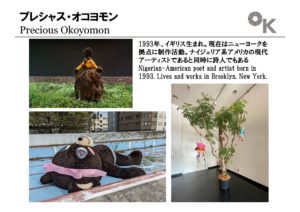 <based on the presentation images>
<based on the presentation images>Hi, I'm Precious Okoyomon and I usually make site-specific works. Kind of everything I've ever made is site-specific to this space. For that piece up on the top corner with all the green kudzu is a piece I made right before the pandemic in Germany at MMK. And it was a room of invasive species in the US, it's actually from Japan called Kudzu. I made a whole garden for it for itself to take over. I made these figures; I call them, "Angels that protect over my garden". A lot of my work is thinking about space, how I could make space for other people, how I can actively create different spaces to play, fragilize, love, and really do whatever you want to do.
The piece I made specifically for here is called, "Touching My Lil Tail Till the Sun Notices Me." She's a giant bear in a pool that wants to be touched (laughs). So, you have to crawl down into the pool and hug her if you wish. It's really thinking about the perverse of childhood and desire and the violence of cuteness. The other work I made that's in the index show is a piece that I showed a really long time ago at LUMA in Zurich and I made a forest of these fig trees and they have lynched stuffed animals on them, which have tied history to the lynchings in the American South. This is the way I like to play with this idea of disarming the viewer to accept this kind of really violent history with the cuteness that comes with it. The idea is that slowly this tree will live and prosper in this space that it's been uprooted for and the little dolls just sway there. I'm going to read you a poem that I wrote after that tree pieces actually.
<reads out the following text >
"I had an unhappy act the other day. I went to see a white man about my mental health. I get it. I'm here. I'm not really here. What does it matter? Spells burning away emotion, Detourn the innocence. The only thing I can control are my emotions if I try hard enough. Shifting flames, release the living body, it is necessary to uproot oneself, to cut down the tree and make of it a cross then to carry it every day. What mind denies its history floating on present breath. Take me back to where I belong. A wound. Wound. Void. I keep forgetting I am the void, LOL. If you think you took something from me, I'm flattered and you can have it. I'll be waiting in blackened faith. The skin stays and the organs move. A wall inside of myself speaks. Extraordinary teeth looking for fuckable orifices. I am afraid things are getting fuzzy now a low-res simulation.
Oh, I wanted to kill but had nothing to kill but myself. I know what I want and I swear to you I'm going to get it. What is more frightful than to die in a nightmare? Lay down there, fill it with red, orange and green. Sustainable thoughts only. I put the earth in my mouth. I plant myself in myself, the hungriest woman in the world is obviously me…duh. I can take everything you're coming at me with. To accept a void in ourselves is supernatural. I become a mystic to kill what hides in violent distance of self I am capable of imagining what I fear and laying it to rest. The suppression of knowledge, the suppression of self-hacked from light I am taking you with me, galvanized spirits. We have nothing to lose. Pre-sky / emit light. Yes, like that. Everything wants to kill you and you should be afraid. Radical modernity requires something of me. Whiteness requires something from me. The world requires something of me. I'm looking for a place to lie down". Thank you.
Chieko Kinoshita:
Thank you very much. You have read a lovely poem. Next, Ms. Barbara, please.
Barbara Sanchez Kane:
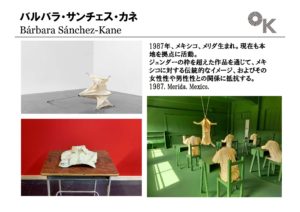 <based on the presentation images>
<based on the presentation images>Hello, very nice to meet you. My name's Barbara Sanchez and I presented an installation called, "Versos Rancios [Rancid verse]". All the materiality of the three pictures you see behind are made of rawhide, and I work in this case with a company in Mexico City. For me, I started with the idea of how materiality could be very, even ephemeral like you don't possess, you will never possess. Because I don't believe in possessing anything. Also, I like the idea to study how the body inhabits the space. For me, our clothing is our first armor, like a first presentation, and the idea of using skins is very anchored to identity.
We need to understand that there's no proper definition of who we are. Everything's transitory, and today I could feel something, and then tomorrow feel the complete opposite. That's just life, I think. One of the first photos is of an umbrella made of rawhide that was actually used for a fashion show. Even like touching different aspects of arts confuse people because they tried to like, define you and be like, you're a fashion designer, you're an artist. For me, it's like using this object that I used in the runway show and then showing it in a different context in a different room so that body becomes a different body. Because it's just a different room and a different space and a different time. "Versos Rancios" for me too, it's like playing with the idea of I come from this fashion system, all this idea about durability or not the durability of clothes, like fast fashion needs to be eradicated. Nowadays, who's in control of women's bodies, our bodies who makes our decisions? It's very important for me to show what is happening in my life, and in my work. It's super personal. Actually, while I was working on this piece, it's actually this piece is dedicated to my assistant. She died in the process. I think art is a passage. Thank you.
Chieko Kinoshita:
Thank you very much. Next, Mr. Shimabuku, please.
Shimabuku:
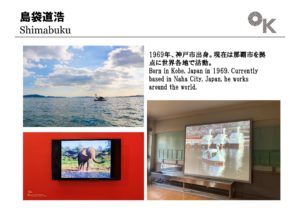 <based on the presentation images>
<based on the presentation images>Hello, my name is Shimabuku. As mentioned earlier by Rirkrit, my mother happened to have grown up in Uchisange in this neighborhood, and it is just a coincidence that she is a graduate of Former Uchisange Elementary School, which is also the venue for this exhibition. I am 53 years old now, but when I was in elementary school, I used to visit Okayama often because my grandparents and relatives were in Okayama.
I often went to the Korakuen Garden and the Okayama Castle, and played on the swan boats there. When I became an adult, I had not been to Okayama for a long time, but when I came here about 10 years ago, I was very surprised, in a good way, to see that Okayama had not changed much. I was very happy to see that the Showa-era atmosphere that I remember from when I was a child was still there. The swan boats I played on had not changed at all at that point and were still there. At the same time, I was surprised that this swan boat had been here for so long while I had been to many places around the world. And then, I felt like I wanted to take it somewhere else, so I made a film titled "Swan Goes to the Sea" in 2012, in which I took the swan boat to the sea down the river. At that time, I could only take the boat to the mouth of the Asahikawa River, or the entrance to the sea, but the people at the Imagineering OKAYAMA ART PROJECT, which is a predecessor of the Okayama Art Summit, asked me if I could try it one more time, so I decided to do it again in 2014.
At that time, they were very considerate of our safety, and the canoeists ran beside us, and I was also lucky to have good winds, so I was able to go to the ocean and get to Inujima with a tailwind (laughs). So, I can show the video based on two performances given in Okayama, and this time, I can show the work here in Okayama. Moreover, this is the school and classroom where my own mother studied. Former Uchisange Elementary School has been in existence for more than 100 years since before World War II, and I heard from my mother that some parts of the schoolyard have not changed at all. It has a very special meaning for me to be able to show my work there.
I also had the opportunity to work with a composer friend of mine, Mr. Makoto Nomura, to create the kind of melody that was playing in my head when I went to the sea on the swan boat. I explained to him what the melody was like and put an iPad in front of the piano to show the video I had edited earlier on. In this way, we created the music together. This is now playing on the second floor of Former Uchisange Elementary School.
There is another work entitled "How do you accept something you don't understand?", and I think it's a work that people will understand when they see it at the venue. Another work is the elephant in this video, which I happened to find when I was walking with Rirkrit once when I went to visit him in Chiang Mai. Actually, I have known Rirkrit since about 25 years ago, when we were invited to an exhibition together at the Sydney Biennale in Australia, and that's how long we have known each other. When I was photographing the elephant, it was moving very fast with shaking its head, but I couldn't tell if it was angry, happy, or what kind of feeling it was having, and I thought that was very interesting. Rirkrit always gives the title "Untitled" and I thought this was "Untitled", then I subtitled "The Elephant we met together in Chiang May". It was shot in Super 8 film, and Rirkrit had asked me to show it to him when it was developed, which was about 12 or 3 years ago. I said I would show it to him at that time, but I hadn't kept my promise yet, so I finally kept my promise this time. Thank you.
Chieko Kinoshita:
Thank you very much. Next, Mr. Yutaka Sone, please.
Yutaka Sone:
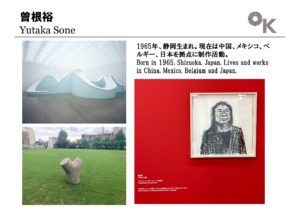 <based on the presentation images>
<based on the presentation images>My name is Yutaka Sone and I am an artist. I have been moving around a lot, so I don't come to this kind of place very often, but I make various kinds of artwork.
However, what I would like to talk about today is something like the war in Ukraine and the recent death of Mr. Godard. I am 57 years old, and I am really, how to say it, angry. Anger. I'm Anger. At the same time, I'm still old.
To be angry is something that requires a lot of physical strength, and if it were true that I was younger, I would be angrier, but I think I could have expressed those emotions, but I don't have the strength to stay angry anymore, and I think I'm a little disqualified as an Anger person.
Even though I am smiling, inside I am angry, and I don't know how long I will stay angry, but I think it is my job to be angry at the time that this liberal art is falling further and further to the ground. I haven't really thought about the question of how this is connected to expression, but it just so happens that Rirkrit is putting on a music stage, a musician's work, so I've been working on music there for about a week. I have a bit of inner anger that I can't continue to work on my own, so I'd like to try to work on it with music. Thank you.
Chieko Kinoshita:
Thank you very much. I heard that there will be a special live performance today, but I would like everyone to hear the anger and sound (laughs). Next, Ms. Haegue Yang, please.
Haegue Yang:
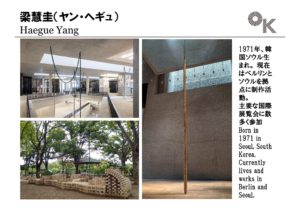 <based on the presentation images>
<based on the presentation images>I'm Haegue Yang, thank you for the invitation. It has been an interesting experience. I cannot agree more with My-Linh that I always feel very unnecessary to add my own voice next to my work. Another agreement with Yutaka. We built the anger zone here, the grumpy old anger, anger zone (laughs). I was thinking like, about why Rirkrit invited me to the show, and I have to confess that I don't dream, I barely remember my dream, but I guess I was thinking about what would have been behind the word dream. Maybe it's a desire, maybe it's an aspiration, need, urgency, or desperation. Many things could be behind the word dream. Even if I don't remember my dream, I'm not a dreamy person. I'm too sober, I guess, but I do think about the synonym of the dream, I guess because somehow all those breakdowns of the word dream in a contemporary sense concern me as one of the traveling voices you saw here on the panel.
As Rirkrit described as "itinerant voices", I guess we somehow build an interesting mapping of our time, mapping of multiple locations, fragmentation, diversion, and dispersion, maybe escaping singular ideas, what the world imposes on each of us. like rolling people into maybe exotic places that we only know through our imagination and aspiration, then maybe reality. I guess maybe that's another intention. I can only guess that Rirkrit put me in multiple locations, and I am in four different locations. You see here, maybe two locations, the Okayama Orient Museum and the Ishiyama Park. Also, Rirkrit chooses to collect, and gather diverse works, as I said, like singular identity. One person could be represented by multiple works, and multiple works could describe one singular person like singular, or plural. And another thing is maybe holistic thinking.
You know, whether it is art or non-art, like the voices and gazes traveling over the distinction and differences. I think that was the thought that came to my mind when I was thinking about why am I here with my colleagues in this show. I think Rirkrit himself also embodies all of this, what we are interested in our time. So, I think I participate in the show out of curiosity, I guess. I think what is illustrated here you can see, and there are two more works, two more locations. One in the shrine and the one in the tea house in Korakuen Park, the tea house called Kankitei Rest House, which is a bit secretive insertion, last-minute insertion by Rirkrit. I think also I have to just admit that I love that kind of gesture, it's not indicated anywhere, (laughs).
It was a last-minute decision that really escaped, let's say, the professional efficiency, and organization of today where we are so used to the user-friendly interface and public services, etc. that when we are thinking about the art, maybe that escapes again, all this like efficiency related notions. I just wanted to mention that there was this element, which became part of my participation. Other than that, I wish that the bench would live its own good life here, which has the very immaterial material, which is the wind, as well as non-human material like vegetation and the very humane civilization of material like bricks. It's like fresh, and bricks, leaves and the wind builds the kind of cohabitation that we are all in. This is part of holistic thinking, too. Thank you again for the invitation.
Chieko Kinoshita:
Thank you very much. Finally, could you please comment about yourself and your work, Mr. Rirkrit?
Rirkrit Tiravanija:
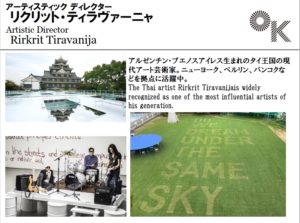 <based on the presentation images>
<based on the presentation images>One of the images is the work at the Imagineering OKAYAMA ART PROJECT before this summit happened, I guess in 2012 or something like that. Then there's Yutaka expressing his anger in China on my… actually, it's kind of my, "Untitled 2017 (Oil Drum Stage)". Yutaka actually made it, so it's really his (laughs). It just partly feels good to just call it Rirkrit's oil drum thing. Then the big image is the lawn in front of the elementary school. When I was starting to do this exhibition, I was told that the artist who curates the exhibition has to also have a piece of work in the show.
And it's a bit against my ethics actually, because I normally when I curate a show, I don't put myself in it, and it's like a rule I have because if I'm curating a show, of course, it's about my ideas, but I don't want to be in the frame, you know? Also, actually, most of my work is about trying to avoid being the center, right? But then I always end up being put into the middle and speaking for whatever. So, I said, Okay, I would like to make this dirt: big huge dirt, playground of the school into a lawn like grass. Then we'll just mold the lawn in such a way that the text of the exhibition will appear on this big lawn.
Now, when I did that, I thought intentionally it was a well-intentioned thing because I thought it would be good for the citizens of Okayama to have a nice green lawn that they can have access to and go on and play on and lie on and enjoy, and then at the same time, I thought once they put this lawn in, of course, they'll have to keep it. It's a huge field, and if you bring all this grass here and you grew it, why would you take it away? So, I thought it was kind of like an improvement of what I thought was a desert. In a way, at the midway point, after it started to happen, I realized there's a reason why it's always a desert (laughs), and it's because, if have a lawn like that, you have to water it. And to water it today is like a big burden on, a lot of things, right? So, maybe it was a kind of mistake… (laughs).
However, we will enjoy it for the time being, and I'm very happy the typhoons keep coming and it's raining heavily the other day (laughs). Today, after the ribbon cutting, just before that happened, everyone said to me, as soon as the ribbon is cut, there will be 120 elementary school children arriving to see the exhibition. And I thought, "Oh, that's really interesting". They arrive and as you see, there are a lot of them. They came from different schools, I think. They have different colored hats. Some had uniforms and some didn't have uniforms, and they started to, of course, go onto the lawn, which was like, you know, a very, I mean, for me were like a little pleasure moment that oh, yes, they knew exactly what to do with it, and this is a good way to start the process of having these children take over this place, you know? As they start to march around, and I wasn't exactly sure what they were going to do, I said to actually our dear translator, I just said, "Maybe they can make a question mark on top of this text." Then she ran out and started to get different people to basically help, and they started to form this question mark.
In fact, it's not something new. I've done this before. So, it's not an invention and it's not an invention also because it was actually coming from, a work of a Czech artist, who I had been familiar with because I had been involved with curating an exhibition in Venice. Mr. Kohler, the artist, Julius Kohler. He was part of the exhibition that I was curating, and I met him, and again, like another older figure who has passed away that I didn't know his work until I met him, one day when I arrived at the exhibition space, and he was with a tennis racket, kind of hitting balls of newspaper into the air. And I look up and the air and there was a tennis net, the net in mid, in the tennis court, but it was hung on the roof, and he was trying to hit the paper up, and I just kind of stood there and watched him. I knew he couldn't really speak English, so we communicated telepathically. Then I went to look at his work and was very inspired. Actually, in that same reference, Julius Kohler, the ping pong, it's hard to see this image, but this is a stainless steel ping pong table that is outside right in front of the castle. And that is also actually a work that was inspired by Julius Kohler. So interestingly, everything comes to a place (laughs).
Chieko Kinoshita:
Every three years, international artists hold an exhibition here in Okayama, and as Mr. Rirkrit mentioned earlier, the concept of this year's theme is different from the past two exhibitions, but instead of comparing it, in the situation that is happening in society and the world today, as Mr. Sone mentioned earlier, art is something that we do not want to see disappear. What should art be now, and why we are existing here? Could you give us a message? First of all, Mr. Sone, please.
Yutaka Sone:
I helped with the production of Rirkrit's show, and before Rirkrit came to the stage, My-Linh was the first to perform on Rirkrit's stage, and I had a lot of fun. Well, angrier rather than fun, and anger is something I get tired of at my age, so I played the drums today.
After this, I would like to finally perform with a musical framework that includes the anger I have been harboring. I think that the way we eventually connected with My-Linh is that Rirkrit's stage began to function. Here's a suggestion, myself, I don't know how each of the other musicians feels about the inside of the band, but we do sessions that last about 45 minutes, or maybe 25 minutes, maybe 30 minutes. Afterward, I and Precious will lead the session, and since we are all traveling around the world, both personally and socially, I would like to share names that we all know, names of roads and streets that we all know, for example, if I say the name of a street, the microphone will go to Precious. Then, maybe other artists will join in, and we can all have a session on the names of the streets that we are personally involved with and know.
Chieko Kinoshita:
Here and now? Or later on stage?
Yutaka Sone:
It is the stage of the Rirkrit in the gymnasium. It's that simple, so if you practice a little like..., Precious, I'll get started. For example...
Yutaka Sone:
"Harrington Drive"
Precious Okoyomon:
"Quincy Street"
Yutaka Sone:
"Falcon Lane"
Precious Okoyomon:
"Marlboro Street"
Yutaka Sone:
"Pacific Strasse"
Excellent! Since we have a common theme of travel, I would like to exchange with everyone the different paths that individuals, briefly, have been involved in as individuals.
Chieko Kinoshita:
Thank you.
Yutaka Sone:
I'd like to ask you later, but there is a little sound from now on, so can I excuse you? Rirkrit?
Chieko Kinoshita:
Is it now!? Are you leaving this place now?
Yutaka Sone:
Must check sounds and set of PAs...
Chieko Kinoshita:
I see...
Yutaka Sone:
Now If you'll excuse me.
Chieko Kinoshita:
After the anger, the road, the sound check, and the current chant, Mr. Sone is leaving this session. Please give Mr. Sone a big round of applause.
Yutaka Sone:
After this, we would like to do that session with all kinds of feelings, so please come to the gymnasium after this and come and see Rirkrit's work as it will finally come to life. Thank you in advance. Thank you all. Thank you for discussing this big conference. Thank you very much, Daniel, My-Linh, Asif, Precious, Barbara, Shimabuku, Haegue, and Rirkrit. Please keep everyone happy in the future. Thank you.
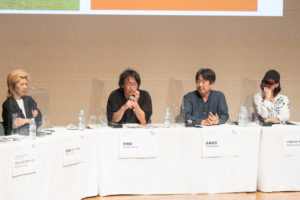
Haegue Yang,Yutaka Sone,Shimabuku,Barbara Sanchez-Kane
Chieko Kinoshita:
Yes, thank you. Then, with loud applause, Mr. Sone is heading to the live performance. Thank you. Now that the baton has been suddenly handed to everyone, Ms. My-Linh, how did you feel after you went up on stage? I would like to ask you how you are enjoying the Okayama Art Summit and what contemporary art activities mean to you.
My-Linh Le:
I'm enjoying it so much. This has been an unbelievable experience, and I think in order to really understand how amazing it is for me, you'd have to know that I've never done any contemporary art, anything (laughs). I'm a street dancer. I've done dance battles, and I've judged dance battles. The film is about as close as I've gotten to contemporary art. Therefore, being here was very random for me. In fact, when I first got the invitation, I thought it was a scam. Then it kept going for so many months, and I thought, "Wow, whoever is trying to scam me deserves some money, because this is a very long game they're playing (laughs)."
I just cannot believe that I'm here sitting up here with all of these amazing artists. Just seeing their work has been very inspiring for me, not just as an artist, but also as a human being. I felt a lot of things just by looking at everyone's art, and I had so much fun on the stage. Everything we do is improvised really (laughs). That's kind of my practice as a street dancer, which is to freestyle in all kinds of ways. That's what we did with our project, "demons of good dreams". But to freestyle with the band, Untitled Band was just another level of improvisation that I was, that was new for me, and it was the moment when one of the band members put their guitar on the stage and stepped away. I've never had that situation come up for me (laughs). Also, the other dancers, they have never been in this situation either where they are freestyling on Rirkrit's oil drum stage in front of an audience with a band playing behind them, and everybody just had a lot of fun. I think they handled it better than I expected. I really appreciated how open everyone's been. I just really enjoy Yutaka-san so much. He's very fun.
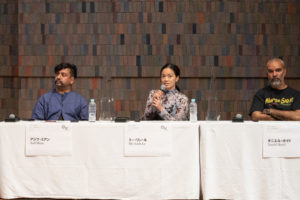
Asif Mian,My-Linh Le,Daniel Boyd
Chieko Kinoshita:
Thank you very much. Mr. Shimabuku, what do you think? Now Mr. Sone has left though...
Shimabuku:
He has left, you know. When I say anger, of course, I think everyone is angry, but if you ask how arts, artists resolve the situation, in his case, he connects it to saying the names of the roads to each other, and I find him an interesting person. I have known him for about 25 years.
I think that Mr. Taro Nasu, who is the general director of this year's exhibition and Rirkrit told us an impressive story at the press conference yesterday that an elementary school student came to the previous exhibition six years ago and showed a great interest in art, and that he came back this time and even studied English to communicate with artists, and this has become the motivation for Rirkrit to curate the exhibition this time. So I thought Art, after all, has to have a lot of windows and doors open, and it has to be accessible to everyone, and I think it would be enough if there were one or two people who could really be saved by art.
Art is very similar to welfare. If there is even one person who really needs it, you have to put up a ramp or a handrail. That is what I think art is about. That's why we are so angry now because a few people... one person... (overwhelmed)
I'm sorry, but unlike Sone-san, my emotion is going in a different direction. I think that what one person does really annoys everyone in the world, and that is why I think that art can make a small number of people, such as an assassination that happened in Nara the other day, or what just happened in Ukraine, really make the world a mess. So, I think that art should be there to help one such person to do something about it.
If it were not for art, we would not know what Sone-san is doing. That's why he is the kind of person he is. There are people who are saved by art, and I think I am one of them, but I think Sone-san is also like that. I think there is a possibility to stop such a person who shoots a gun in Nara or makes a mess in Ukraine, if we can stop him. I think that's why we are trying to open a window for everyone and hope that we can really reach even one person.
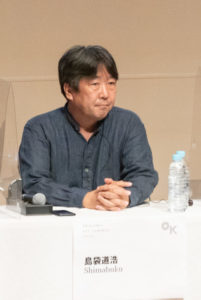 Shimabuku
ShimabukuChieko Kinoshita:
Thank you very much. How about you, Haegue-san, after listening to what he just said? You were nodding deeply at Shimabuku's talk, but could you say something about what you think art is?
Haegue Yang:
Yes, I'm actually very impressed... (being at a loss for words and returning the microphone)
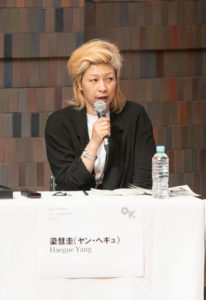 Haegue Yang
Haegue YangChieko Kinoshita:I think it is very good to be silent. I think that perhaps Mr. Sone's response to Ms. Barbara's earlier comment, "Art is a passage," started a session on the path. Could you give us some comments on what you have heard so far?
Barbara Sanchez Kane:
Well, for me, it's a different way of freedom. And when I meant passage is a passage to actually, for me, it will be surviving to be like, in this world, I will not like, I have the privilege to be able to work and to present my work and actually like dreaming and seeing it tangible and in front of me. Because I think, for me, I always say like, there's a supportive of when you draw you have this idea in your mind. And when you put it on a piece of paper, it's exactly that moment of excitement that you never know if the idea will change. The first time when you extract this image from what you're thinking to a piece of paper, I think that's the sexiest part of the whole process. And to be able to see your work and how people approach, how another person's reaction to your work is a whole different story. And that's why, like talking about my work is like giving all the answers or trying to give all the answers, but I don't even know all the answers. So, the confrontation of you with the work of art is what actually makes the artwork live. For me is the new forms of freedom,
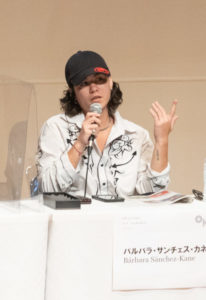 Barbara Sanchez-Kane
Barbara Sanchez-KaneChieko Kinoshita:
Mr. Asif, you have been combining science and art, including technologies that exist today and those that are trying to create or revive something that doesn't exist yet. What is your idea of art?
Asif Mian:
I think making something that doesn't exist is exciting. I also think, you know, this discussion of anger or not liking something is a good starting point (laughs). Like um, Not liking a desert and putting a lawn. It also, what was everyone speaking. One of my early works was performance responses to being bullied in high school. And so, I would recreate a fight, but change the rules. We'd move very, very slow and on the ground, and then it turned into more of a dance. So, but in a very kind of peculiar way, laying on the ground and in a parking lot. , I think the idea of not liking something or not agreeing with it can be an inspiration, like a good point, a good starting point. And I do not like surveillance or drones or this, some of this technology, so how can I mess it up (laughs)? You know, how can I just subvert it? And create something more, maybe magical or more mythological or more something a kid would like, just like a ghost or something. So yeah, that's art for me.
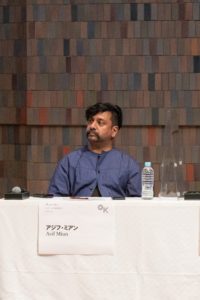
Asif Mian
Chieko Kinoshita:
What does art mean to you, Mr. Daniel? I was going to ask only one of the same questions today.
Daniel Boyd:
I think art is a proposition, or it is about communication. And I think the beauty of this show is like Rirkrit was explaining, it's about the periphery, so these voices that, or these experiences, these shared experiences that don't necessarily have the opportunity to become a part of a whole. So, I think these scenarios, these situations are integral to amalgamating those are more collective, sense of relation. I think it's about communication.
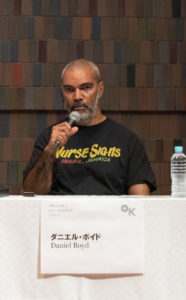 Daniel Boyd
Daniel BoydChieko Kinoshita:
What do you think, Ms. Precious?
Precious Okoyomon:
For me, I'm always thinking that art is this kind of world-building portal that we get to create. I think right now we're at this kind of end of history and it's interesting to be living at this time and thinking and processing how we want to build a new world. And I think that's what art does. It's this continuous new language of thinking, how we can collectively dream together to build a new world, which is basically all I want to do ever.
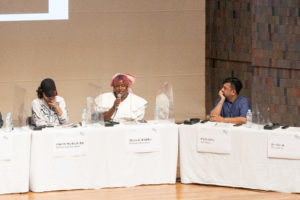
Barbara Sanchez Kane,Precious Okoyomon,Asif Mian
Chieko Kinoshita:
Ms. Hague Yang, did you get the words out? Are you okay?
Haegue Yang:
…(silence)
Chieko Kinoshita:
Okay, I would like to go deeper and deeper, but time is a finite resource, and I would like to keep it that way. Mr. Rirkrit, please give us your comments on how you hope that the Okayama Art Summit that has just started will be conveyed to the people of Okayama and the people of the world.
Rirkrit Tiravanija:
I usually only cry in the airplane for some reason, but I'm feeling it today. Um, no, I mean, I'm touched by the work (pause) and I'm really pleased that you all stepped inside the doors that are normally closed to you. (overwhelmed)
Chieko Kinoshita:
Seems like you are at a loss for words...
Shimabuku:
It was a weird talk (laughs).
Chieko Kinoshita:
It's a weird talk, but I really, truly believe it's a great talk.
(Applause from the audience)
I would be very happy if one of these silent talks could be a day or a step that represents a change in your image of this Okayama Art Summit and the world, or a power that will change your image of the world in the future. What do you think, Mr. Shimabuku?
Shimabuku:
If you go to see Mr. Sone's performance, please say hello to him. Tell him, what happened after he left. Please tell him that he shouldn't have left early (laughs).
Rirkrit Tiravanija:
I want to thank everyone for being here. I want to thank Daisuke Harada-san who has been giving me a hard time, or I've been giving him hard time all this time. Thanks. Thanks to Okayama and the people here.
I think art is like, you know, going to this ramen place with friends you love, and meeting these old ladies who are cooking and enjoying being with them and feeling like that we are together. (overwhelmed) Thank you.
(Artists exeunt)
Chieko Kinoshita:
I would like to thank all of you for your tears and hearts for one historic and truly wonderful Artists Talk of the Okayama Art Summit 2022 and the Special Talk that we were able to share time and many things. Thank you very much.
(Applause from the audience )
It was supposed to be a photo session, but that has already been muddied by your words, and I would like to thank all the people online, the audience, and the artists for this very special time and your stories today. I hope that you will deliver your words and thoughts on the Okayama Art Summit 2022 that starts today. Thank you very much. Thank you very much.
NEXT
アーティスト


